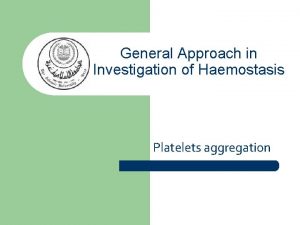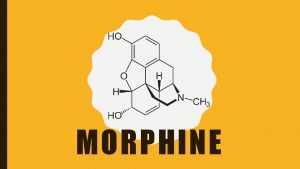Mechanisms of morphine potentiated agonistinduced platelet aggregation in


- Slides: 2


Mechanisms of morphine potentiated agonistinduced platelet aggregation in human platelets n The discovery of pharmacological activity of morphine early in the 19 th century and the demonstration of its potent analgesic properties. Morphine had been used to relax the pain of cancer patients on the last phase , and dealed with some serious diseases、trauma and surgery was needed. However, how the influence of morphine on wash human platelets, and what are the mechanisms involved in this influence, it still remains unclear. Recently the subject had not been discussed widely. The aim of this thesis is to further investigate the detailed mechanisms of morphine on human platelets. In our studies, we found that morphine (1, 5 �M) dose—dependently potentiated platelet aggeregation and ATP release by collagen (1 �g/ml) and U 46619 (0. 5 ���� in human platelet suspensions. Morphine (5 �M) potentiated [3 H��� inositol monophosphate formation stimulated by collagen (5 �g/ml) in [3 H��myoinositol loaded platelets. Furthermore, morphine also potentiated [Ca 2+]i mobilization in human platelet suspensions stimulated by collagen (1 �g/ml). At the same dose, morphine significantly potentiated thromboxane B 2 formation of collagen-activated platelets. Consequently, we measured prostagladin. E 2 formation as an index of cyclooxygenase activity. We found that morphine had no significant effect on cyclooxygenase activity, and found it did not potentiate collagen-induced platelet aggregation in the presence of yohimbine. According to these results, we found the effect of morphine on human platelets may be mediated via activation of ��� adrenoceptors. On the other hand, morphine (1, 5 ��) inhibited prostaglandin E 1 (10 ������ induced cyclic AMP increase in human platelets. We examined this potentiation involved in platelet signal transduction system such as Na�/H� pump in human platelet suspensions. In contrast, morphine did not significantly increase nitrate formation in human platelets. Moreover, we found morphine did not influence the binding of FITC-triflavin to platelet glycoprotein IIb/IIIa complex. Triflavin, an Arg-Gly-Asp-containing antiplatelet peptide, was purified from Trimeresurus flavoviridis snake venom. Measurement of the platelet membrane fluidity, we found that morphine did not significantly affect the platelet membrane fluidity diphenylhexatriene (DPH)-loaded platelets. Based on the above observations, we suggested that morphine may bind to ��� adrenoceptors in human platelets, resulting in inhibition of cyclic AMP formation and concurrently increased intracellular Ca 2+, resulting in activation of phospholipase A 2 , and increased formation of thromboxane A 2 formation, and potentiation of platelet aggregation.



